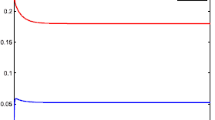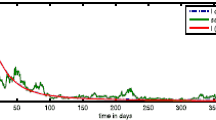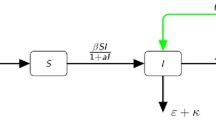Abstract
The stochastic SEIR infectious diseases model with saturated incidence rate is studied in this paper. By constructing appropriate Lyapunov functions, we show that there is a stationary distribution for the system and the ergodicity holds provided \({R}_{0}^{s}\) > 1. In particular, we improve the results obtained by previous studies greatly, condition in our Theorem is more concise and elegant.
Similar content being viewed by others
Introduction
The study of the epidemic models have long been and will continue to be one of the dominant themes in mathematical biology due to its importance at both understanding the spread and control of infectious diseases in a community. Many researchers have made a significant progress on SIR models1,2,3,4,5,6, where S, I, R denote the fractions of the susceptibles, the infectives and the recovered hosts in the population respectively. SIR models assume the disease has no latent period. However, for some diseases, such as hepatitis B, AIDS, sometimes has to be passed before an infected individual becomes infectious. Therefore, an extra class, the class of exposed hosts (E), should be added to the system, where E denotes the fraction of the exposed population. The model is called SEIR (susceptible-exposed-infected-removed) model, and SEIR models were investigated by many researchers7,8,9.
On the other hand, the incidence rate palys an important role in the epidemics models. some authors employ the bilinear incidence rate βSI 10, 11. After studying the cholera epidemic spread in Bari in 1973, Capasso and Serio12 introduced a saturated incidence rate g(I)S into epidemic models, where g(I) tends to a saturation level when I gets large, i.e.
where βI measures the infection force of the disease and \(\tfrac{1}{1+\alpha I}\) measures the inhibition effect from the behavioral change of the susceptible individuals when their number increases or from the crowding effect of the infective individuals. Then the SEIR model with a saturated incidence rate can be described as follows:
The parameters in the model are positive constants and summarized in the following:
Define the basic reproductive number \({R}_{0}=\frac{\lambda \beta \theta }{{d}_{S}(\theta +{d}_{E})({d}_{1}+\delta +\gamma )}\). The dynamical behavior of model (1.1) is as follows ref. 13:
If R 0 < 1, system (1.1) has a unique disease-free equilibrium \({P}_{0}=(\frac{\lambda }{{d}_{S}},0,0,0)\), which is a global attractor in the first octant.
If R 0 > 1, then model (1.1) has two equilibria, a disease-free equilibrium P 0 and an endemic equilibrium P* = {S*, E*, I*, R*}. P 0 is unstable and P* is a global attractor in the interior of the first octant.
Some authors take stochastic perturbation into account when they investigate the epidemics system14,15,16,17,18,19,20,21. In this paper, we assume that the perturbation is of white noise type, that is, \({d}_{S}\to {d}_{S}+{\sigma }_{1}{\dot{B}}_{1}(t)\), \({d}_{E}\to {d}_{E}+{\sigma }_{2}{\dot{B}}_{2}(t)\), \({d}_{I}\to {d}_{I}+{\sigma }_{3}{\dot{B}}_{3}(t)\), \({d}_{R}\to {d}_{R}+{\sigma }_{1}{\dot{B}}_{4}(t)\), then we get the following stochastic system
where \({B}_{1}(t)\), \({B}_{2}(t)\), \({B}_{3}(t)\), \({B}_{4}(t)\) are standard one-dimensional independent Wiener processes, \({\sigma }_{i}({\sigma }_{i} > 0),i=1,2,3,4\) are the intensity of the white noise.
In ref. 17, Yang et al. show that there is a stationary distribution μ(·) for system (1.2) and it has ergodic property provided the following conditions hold:
where (S*, E*, I*, R*) is the interior equilibrium of system of (1.1), \({k}_{1}={d}_{S}-{\sigma }_{1}^{2}-\frac{{\sigma }_{1}^{2}{({d}_{E}+{d}_{S}+\theta )}^{2}{S}^{\ast }}{{d}_{S}({d}_{E}+\theta )}\), \({k}_{2}=\frac{{d}_{E}+\theta }{4}-{\sigma }_{2}^{2}\), \({k}_{3}=\frac{({d}_{I}+\delta +\gamma )({d}_{E}+\theta )}{8{\theta }^{2}}({d}_{I}+\delta +\gamma -4{\sigma }_{3}^{2})\), \({k}_{4}=\frac{{d}_{R}{({d}_{I}+\delta +\gamma )}^{2}({d}_{E}+\theta )}{8{\theta }^{2}{\gamma }^{2}}({d}_{R}-2{\sigma }_{4}^{2})\), and
The main aim of this paper is to deal with the existence of stationary distribution of system (1.2). By construct new Lyapunov functions and rectangular set, instead of elliptical region, our results do not depend on the equilibrium P* of the deterministic system (1.1), which will improve the above result to a great extent.
Ergodic Properties
In order to show the existence of a stationary distribution, firstly, we cite a known result from ref. 22 as a lemma.
Let X(t) be a homogeneous Markov Process in E l (E l denotes l dimensional Euclidean space), and is described by the following stochastic equation:
The diffusion matrix is defined as follows:
Lemma 2.1. The Markov process X(t) has a unique ergodic stationary distribution μ(·) if there exists a bounded domain U ∈ E l with regular boundary Γ and
A 1: there is a positive number M such that \(\sum _{i,j=1}^{l}\,{\lambda }_{ij}(x){\xi }_{i}{\xi }_{j}\ge M{|\xi |}^{2},\,x\in U,\,\xi \in {R}^{l},\)
A 2: there exist a nonnegative C 2–function V such that LV is negative for any E I \U. Then
for all x ∈ E l , where f(·) is a function integrable with respect to the measure μ.
Theorem 2.1. Assume that
then for any initial value \((S\mathrm{(0)},E\mathrm{(0)},I\mathrm{(0)},R\mathrm{(0))}\in {R}_{+}^{4}\), there is a stationary distribution μ(·) for system (1.2) and the ergodicity holds.
Proof. First, we denote
It is easy to see that b > 0. Constructing a C 2–function \(Q:{R}_{+}^{4}\to {R}_{+}\) in the following form
where
p and ρ are constants satisfying the following condition respectively
and A is determined in the following proof. It is easy to check that
where \({U}_{k}=(\frac{1}{k},k)\times (\frac{1}{k},k)\times (\frac{1}{k},k)\times (\frac{1}{k},k)\). Besides, Q(S, E, I, R) is a continuous function. Hence, Q(S, E, I, R) must have a minimum point (S 0, E 0, I 0, R 0) in the interior of \({R}_{+}^{4}\). Then we define a C 2– and nonnegative function \(V:{R}_{+}^{4}\to {R}_{+}\) as following
According to Itô’s formula, we get
Applying inequality \(a+b+c\ge 3\sqrt[3]{abc},a,b,c > 0\), yields
Similarly,
where
and f is defined in (2.3). We also obtain that
and
Therefore
Consider the following bounded subset
where \({\epsilon }_{1},{\epsilon }_{2} > 0\) are sufficiently small numbers satisfying the following conditions
where
We note that for sufficiently small \({\epsilon }_{1}\), condition (2.9) holds due to (2.2). Then
where
Therefore we consider the following eight cases:
Case 1. If (S, E, I, R)∈D 1,
Then it follows from (2.10) that
Case 2. If (S, E, I, R) ∈ D 2, we have
Using condition (2.9), we obtain
Case 3. If (S, E, I, R) ∈ D 3, we obtain that
Choosing
yields
The last inequality holds according to (2.11).
Case 4. If (S, E, I, R) ∈ D 4, condition (2.12) combining with (2.15) gives
Case 5. If (S, E, I, R) ∈ D 5, we obtain that
this together with (2.13), we derive that
Case 6. If (S, E, I, R) ∈ D 6,
which follows from (2.13).
Case 7. If (S, E, I, R) ∈ D 7, it follows that
which together with (2.14) implies that
Case 8. If (S, E, I, R) ∈ D 8, we obtain that
Combining (2.14), yields
Based on the discussion of the above eight cases, we obtain
Therefore, A 2 in Lemma 2.1 is satisfied. In addition, A 1 is also satisfied (see ref. 17). Theorem 2.2 is proved according to Lemma 2.1.☐
Remark 2.1. Yang et al.17 have studied system (1.2), in Theorem 3.3 they show that under conditions (H1) and (H2), there is a stationary distribution μ(·) for the system. Comparing with Theorem 2.2 in our investigation, we only need condition \({R}_{0}^{s} > 1\), without other conditions imposed on the coefficients. That is to say, Theorem 2.2 in large improves Theorem 3.3 in ref. 17. Moreover, we see that if σ i = 0 (i = 1, 2, 3, 4), the above condition is reduced to R 0 > 1, which is the condition for globally asymptotically stable of endemic equilibrium P* of system (1.1). And \({R}_{0}^{s}\) is smaller than the basic reproduction number R 0 of system (1.1).
References
Kermack, W. O. & McKendrick, A. G. Contribution to mathematical theory of epidemics. P. Roy. Soc. Lond. A Mat. 115, 700–721 (1927).
Pathak, S., Maiti, A. & Samanta, G. P. Rich dynamics of an SIR epidemic model. Nonlinear Anal. 15, 71–81 (2010).
Anderson, R. M. & May, R. M. Infectious Diseases of Humans: Dynamics and Control (Oxford University Press, Oxford, 1998).
Beretta, E. & Takeuchi, Y. Convergence results in SIR epidemic model with varying population sizes. Nonlinear Anal. 28, 1909–1921 (1997).
Korobeinikov, A. Lyapunov functions and global stability for SIR, SIRS, and SIS epidemiological models. Appl. Math. Lett. 15, 955–960 (2002).
Ruan, S. G. & Wang, E. D. Dynamical behavior of an epidemic model with a nonlinear incidence rate. J. Differential Equations 188, 135–163 (2003).
Li, M. Y. & Muldowney, J. S. Global stability for the SEIR model in epidemiology. Math. Biosci. 125, 155–164 (1995).
Li, M. Y., Smith, H. L. & Wang, L. C. Global dynamics of an SEIR epidemic model with vertical transmission. SIAM J. Appl. Math. 62, 58–69 (2001).
Gao, S., Chen, L. & Teng, Z. Pulse vaccination of an SEIR epidemic model with time delay. Nonlinear Anal. Real World Appl. 9, 599–607 (2008).
Gabriela, M., Gomes, M., White, L. J. & Medley, G. F. The reinfection threshold. J. Theor. Biol. 236, 111–113 (2005).
Wang, W. & Ruan, S. Bifurcation in epidemic model with constant removal rate infectives. J. Math. Anal. Appl. 291, 775–793 (2004).
Capasso, V. & Serio, G. A generalization of the Kermack-Mckendrick deterministic epidemic model. Math. Biosci. 42, 43–61 (1978).
Korobeinikov, A. Global properties of infectious disease models with nonlinear incidence. Bull. Math. Biol. 69, 1871–1886 (2007).
Lahrouz, A. & Settati, A. Asymptotic properties of switching diffusion epidemic model with varying population size. Appl. Math. Comput. 219, 11134–11148 (2013).
Lahrouz, A. & Settati, A. Necessary and sufficient condition for extinction and persistence of SIRS system with random perturbation. Appl. Math. Comput. 233, 10–19 (2014).
Lin, Y. G. & Jiang, D. Q. Threshold behavior in a stochastic SIS epidemic model with standard incidence. J. Dyn. Diff. Equat. 26, 1079–1094 (2014).
Yang, Q. S., Jiang, D. Q. & Shi, N. Z. The ergodicity and extinction of stochastically perturbed SIR and SEIR epidemic models with saturated incidence. J. Math. Anal. Appl. 388, 248–271 (2012).
Yang, Q. S. & Mao, X. R. Extinction and recurrence of multi-group SEIR epidemic models with stochastic perturbations. Nonlinear Anal. Real World Appl. 14, 1434–1456 (2013).
Liu, M., Bai, C. & Wang, K. Asymptotic stability of a two-group stochastic SEIR model with infinite delays. Commun. Noninear. 19, 3444–3453 (2014).
Zhang, X. H. & Wang, K. Stochastic SEIR model with jumps. Appl. Math. Lett. 26, 133–143 (2013).
Witbooi, P. J. Stability of an SEIR epidemic model with independent stochastic perturbations. Phys. A. 392, 4928–4936 (2013).
Has’minskii, R. Z. Stochastic Stability of Differential Equations. In: Monogr. Textb. Mech. Solids Fluids, vol. 7 (Sijthoff & Noordhoff, Alphen aan den Rijn. Netherlands, 1980).
Acknowledgements
The work was supported by NSFC of China Grant (No.11371085), the Fundamental Research Funds for the Central Universities (No. 15CX08011A), Scientific Research Foundation of Jilin Department of Education (No. 2015356), STDP of Jilin Province (Grant No. 20150520052JH) and Natural Science Foundation of Changchun Normal University.
Author information
Authors and Affiliations
Contributions
Qixing Han and Liang Chen wrote the main manuscript text. Daqing Jiang suggested to investigate the problem mentioned in the manuscript and review the manuscript with Liang Chen who also revised some typos of the original manuscript.
Corresponding authors
Ethics declarations
Competing Interests
The authors declare that they have no competing interests.
Additional information
Publisher's note: Springer Nature remains neutral with regard to jurisdictional claims in published maps and institutional affiliations.
Rights and permissions
Open Access This article is licensed under a Creative Commons Attribution 4.0 International License, which permits use, sharing, adaptation, distribution and reproduction in any medium or format, as long as you give appropriate credit to the original author(s) and the source, provide a link to the Creative Commons license, and indicate if changes were made. The images or other third party material in this article are included in the article’s Creative Commons license, unless indicated otherwise in a credit line to the material. If material is not included in the article’s Creative Commons license and your intended use is not permitted by statutory regulation or exceeds the permitted use, you will need to obtain permission directly from the copyright holder. To view a copy of this license, visit http://creativecommons.org/licenses/by/4.0/.
About this article
Cite this article
Han, Q., Chen, L. & Jiang, D. A note on the stationary distribution of stochastic SEIR epidemic model with saturated incidence rate. Sci Rep 7, 3996 (2017). https://doi.org/10.1038/s41598-017-03858-8
Received:
Accepted:
Published:
DOI: https://doi.org/10.1038/s41598-017-03858-8
- Springer Nature Limited




